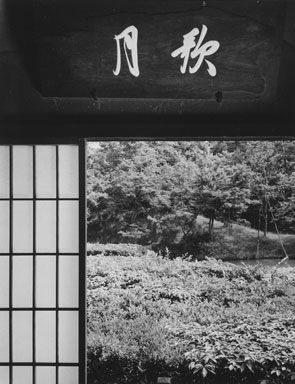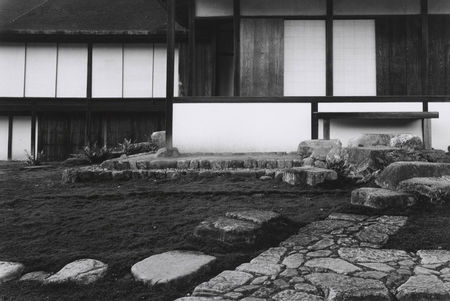'Katsura: Picturing Modernism in Japanese Architecture, Photographs by Ishimoto Yasuhiro' @ MFAH
Ishimoto Yasuhiro, (Japanese, born 1921), Untitled from the series Katsura, 1953-54. Gelatin silver print, printed 1980-81. The Museum of Fine Arts, Houston; Gift of the artist in memory of Ishimoto Shigeru, 2009.243 © Ishimoto Yasuhiro.
HOUSTON, TX.-Photographer Ishimoto Yasuhiro (b. 1921) is widely acknowledged as one of the most influential figures in the development of postwar Japanese photography. Among his most celebrated bodies of work are the photographs he took during 1953-54 of the legendary 17th-century Imperial villa of Katsura, in Kyoto, which infuse the images of the iconic structure with a modernist Bauhaus esthetic. Beginning June 20, 2010, the MFAH will exhibit 70 of these photographs—presenting the images, for the first time, un-cropped and as Ishimoto had originally intended for them to be seen.
For the last 50 years these photographs have been known only from the landmark 1960 book Katsura: Tradition and Creation in Japanese Architecture, by architect Tange Kenzo with an introduction by Walter Gropius. For that publication, Tange rigorously cropped and sequenced the photographs to promote his agenda in a debate that consumed post-occupation Japan´s cultural elite in the mid-1950s: that of the vital relevance and existence of tradition in their efforts to define modernity. Against this backdrop, the show will explore the nuanced and complex relationship between architecture and photography, and the profound impact these photographs had on the public´s interpretation of Japanese tradition in modern architecture.
"The MFAH received a major gift of 300 photographs from Ishimoto Yasuhiro last fall, and the collection of some 400 photographs now includes work from all of the artist´s major series, including Katsura," said Dr. Peter C. Marzio, MFAH director. "This is the first time that so many of Ishimoto´s famous photographs of Katsura will be on view in Houston, and the first time that the uncropped images will be shown in such depth."
"The 1960 Katsura book is regarded as one of the most important books of an architect´s interpretation of built environments through photography in the 20th century — on par with Philip Johnson and Henry-Russell Hitchcock´s The International Style: Architecture Since 1922 (1932)," commented Yasufumi Nakamori, assistant curator of photography, MFAH, and curator of the exhibition. "But the book also represented a perspective specific to postwar Japanese culture. Its images and ideas crystallized the Japanese interpretation of Bauhaus esthetics and functionalism, and gave a cue to a younger generation of Japanese architects in mid-century Japan, including Tange Kenzo and Horiguchi Sutemi, who had been struggling to locate tradition in their modern designs. To Tange, the book was a visual manifesto for his postwar design philosophy, and proved that the function-based expressions of pre-modern Japanese architecture were still relevant, coupled with new architectural technologies and materials."
The Katsura Photographs and the Exhibition
During 1953 and 1954, Ishimoto extensively photographed the Imperial Villa of Katsura, near Kyoto. He had just returned to Japan after 14 years in the U.S., including training with Harry Callahan at the "New Bauhaus" of the Institute of Design at the Illinois Institute of Technology. Ishimoto´s unique take on Katsura compared the geometry of the villa to the grid-like composition of a Mondrian painting, and the organic arrangement of the villa´s stepping stones to Arp´s collages and sculptures. In all, Ishimoto produced 300 black-and-white photographs with his large-format camera. The images, which often fragment and abstract the villa architecture and garden, are in dramatic contrast to all earlier photographic depictions of Katsura, which had been photographed as early as 1873 in a nostalgic, Pictorialist style. In these photographs, Ishimoto placed his newfound Bauhaus heritage ahead of his traditional, Japanese one.
During these same years, Japan´s cultural elite were struggling to define their own modernity in the post-occupation era, and Ishimoto´s friend and mentor, architect Tange Kenzo, was at the forefront of the debate called dento ronso (the debate over tradition). Ishimoto invited Tange to write an essay in the photographer´s would-be first monograph: the book of his photographs of Katsura. Over the four-year process, however, Ishimoto´s participation gradually receded, and the book became Tange´s own manifesto to display the significance of pre-modern architecture in his postwar architectural designs.
For the exhibition Katsura, curator Nakamori has culled 70 photographs from the 300 Ishimoto originally took, working closely on the selection with Ishimoto himself. With the presentation in Houston, Ishimoto´s original vision will be fully presented for the first time — without the cropping and sequencing that imparted such specific meaning in their original publication. In these black-and-white photographs, the Katsura villa, its many buildings, and its carefully landscaped grounds are imbued with an esthetic that Ishimoto characterized as "avant-garde." Traditional screens, room dividers and the structure´s beams and columns emphasize their geometric abstraction; the meticulously placed stones and tended grasses relate to the built environment much in the same way that Modernism called for the seamless coexistence of architecture and nature.
Ishimoto Yasuhiro
Ishimoto was born to Japanese parents in San Francisco in 1921, moved to Japan at age three, and then returned to the United States in 1939. While working on a farm, he began studying agriculture at the University of California, but with the advent of World War II, he was sent to an internment camp in Colorado for two and a half years.
It was at the internment camp that Ishimoto learned photography from fellow detainees. In early 1945, he was released and moved to Chicago — one of the few U.S. cities that authorized the second generation Japanese Americans who had once returned to Japan, as it was not a coastal region — to begin a new life. He briefly studied architecture at Northwestern University. While supporting himself as a silkscreen artist, he then transferred to the Institute of Design, where he studied with Harry Callahan and Aaron Siskind.
Ever since, the cities of Chicago and Tokyo and traditional Japanese art and architecture have been among Ishimoto´s major photographic subjects—filtered through his unique ways of seeing, cultivated with the aesthetic principles of the New Bauhaus, and later imbued with the Japanese aesthetic principle, kirei-sabi.
The artist´s career was launched early on when he was tapped by The Museum of Modern Art curator Edward Steichen for the legendary Family of Man exhibition (1955), and over the next 50 years he would exhibit internationally. His work is in the collections of the MFAH, MoMA, The Art Institute of Chicago, Canadian Centre for Architecture, Princeton University Art Museum, Tokyo Metropolitan Museum of Photography, the Kochi Museum of Art, and the National Museum of Art, Tokyo.
In 1983, Ishimoto was awarded Japan´s Medal of Honor with Purple Ribbon, and in 1993, the Japanese government also awarded him with the Fourth Order of Merit with the Cordon of the Rising Sun. Most recently, in 1996, the Japanese government named him a "Man of Cultural Distinction."
In addition to Katsura: Tradition and Creation in Japanese Architecture (1960 and 1972), major publications of Ishimoto´s work include Someday, Somewhere (1958), Chicago, Chicago (1969), Shibuya, Shibuya (2007), and Composition: Form and Color (2008).
Ishimoto Yasuhiro, (Japanese, born 1921), Untitled from the series Katsura, 1953-54. Gelatin silver print, printed 1980-81. The Museum of Fine Arts, Houston; Gift of the artist in memory of Ishimoto Shigeru, 2009.265 © Ishimoto Yasuhiro
Ishimoto Yasuhiro, Untitled (from the series "Katsura"), 1953—54. . Gelatin silver print, printed 1980—81 © Ishimoto Yasuhiro 2009.253

/https%3A%2F%2Fprofilepics.canalblog.com%2Fprofilepics%2F1%2F0%2F100183.jpg)





/http%3A%2F%2Fstorage.canalblog.com%2F55%2F51%2F119589%2F48505917_p.jpg)
/http%3A%2F%2Fstorage.canalblog.com%2F04%2F29%2F119589%2F43164111_p.jpg)
/http%3A%2F%2Fp9.storage.canalblog.com%2F92%2F51%2F119589%2F98216442.jpg)
/https%3A%2F%2Fassets.over-blog.com%2Ft%2Fcedistic%2Fcamera.png)